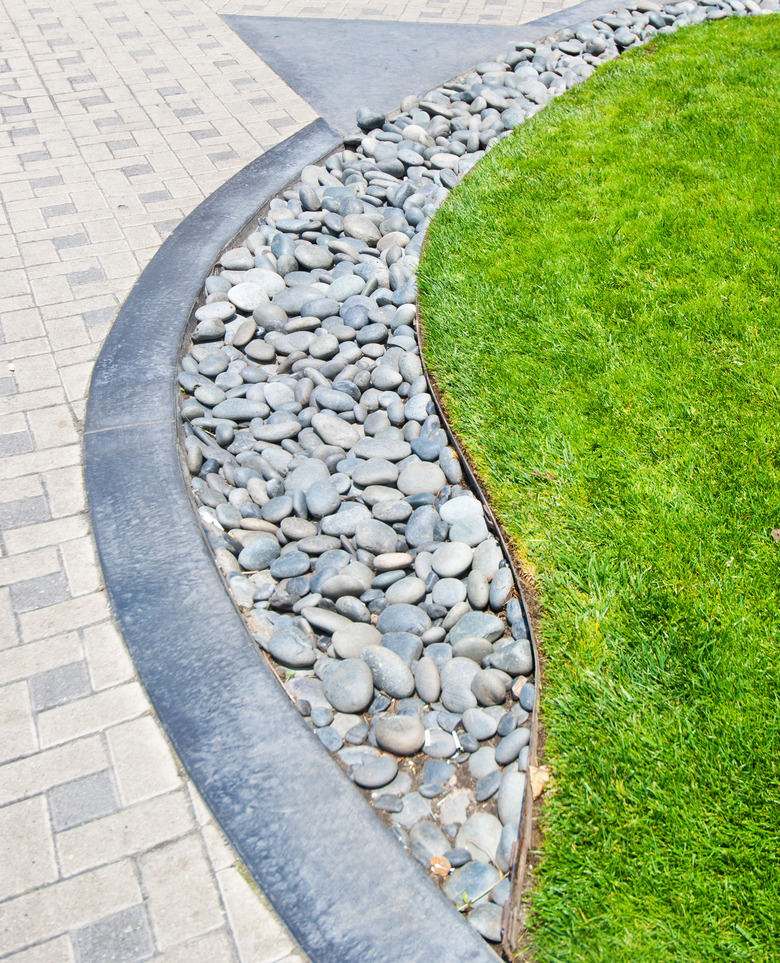How To Install Metal Lawn And Landscape Edging
We may receive a commission on purchases made from links.
Metal landscape edging stands out among common forms of edging as far as its overall appearance, longevity and durability are concerned. Clean, straight lines and moderate curves are possible with metal lawn edging depending on the thickness of the edging and its composition. Some forms are also a little easier to install in your garden than their nonmetal counterparts, as the pre-installation digging essentially requires a slit rather than a wide hole.
Steel or Aluminum Landscape Edging
Steel or Aluminum Landscape Edging
When it comes to metal edging, two materials rule the yardscape: steel and aluminum. Steel tends to be sturdier and more durable, while aluminum edging is generally more flexible. Uncoated steel lawn edging develops a rusty patina over time, while aluminum does not. If you prefer a steel edging and live in a climate where it may rust, choose a coated steel if you want it to maintain its original hue over the years.
Corrugated steel is a bit different from many other forms of metal edging in that it's essentially a roll of corrugated metal cut into common edging heights. There are no metal stakes included with or attached to this edging. Instead, a wooden garden stake or post is used behind seams to prevent gaps between pieces of edging. Corrugated steel edging is quite flexible, so it's a good candidate for curved beds or even complete circles.
How much corrugated steel sticks out of the ground is entirely up to you as long as at least 1/3 of the total height is below ground. For this reason, it could do a better job holding mulch or other landscaping materials in the garden bed, as many other forms of metal edging are designed to sit nearly flush with the ground.
Unlike steel, aluminum lawn edging won't rust. It also tends to be more flexible and lightweight than comparable steel edging. Since aluminum is a softer metal, it's easier to bend, but it's also more prone to dents and dings, which may happen if a car backs over it. For this reason, aluminum is best if nearly the entire height of the edging sits close to ground level rather than sticking up an inch or so. Thin aluminum can be very flimsy, so if you're set on using aluminum, pick the thickest option available.
Measure the Area First
Measure the Area First
Before you buy metal or any type of lawn edging, measure the perimeter of the project area. For instance, if you're installing edging on the sides of the driveway and a walkway leading up to the house, use a tape measure to measure each span, such as both the left and right sides of the driveway, in case their lengths vary.
Twine offers a handy way to measure curves and irregular shapes. For each area you plan to edge, stretch the twine as an outline from the starting point to the ending point of the area you want to edge. The twine should sit exactly where the edging will go. Straighten and measure each length of twine, add up the total length and then add at least another foot or so to account for overlaps, which vary depending on the style of the edging you'll use. All metal edging can be cut to length with a hacksaw, tin snips or a similar tool, so keeping a little extra on hand is a good idea in case you ever want to replace a portion.
Design Styles Vary
Design Styles Vary
Besides the composition, thickness and height of any piece of metal edging, the way it's designed for installation also varies from one type to the next. For instance, the ends on some pieces of Sure-Loc aluminum edging are cut so the top of one end sits above the bottom adjacent edge rather than overlapping it. Holes for metal spikes align if the pieces are properly positioned, making it easy to secure one piece to another during the installation process.
Some metal edging has the spikes already attached to the bottom of the strip or metal teeth that look like an enlarged view of a saw blade. Whether the spikes are attached or not, you'll still have to hammer the average metal edging into place to ensure it stays put. Even once you backfill the area, if the bottom of the edging isn't securely set into the ground, it will pop out easily, as is the case with solar landscape lights.
Always read the instructions that come with the edging because no matter the brand or the style, there's one side that's meant to face out toward the lawn, while the other side faces the soil, mulch or landscaping materials in a flower bed, for instance. The instructions also offer the best suggestions for bending angles into the material, as some metal edging is easy to bend by hand by positioning a block of wood over the edging and tugging the edging upward. Others may require cutting a notch in the bottom to make the metal easier to bend.
Digging a Slot for Edging
Digging a Slot for Edging
The slot or narrow trench required for metal edging installation is a lot narrower than needed for most other types of landscape edging since the spikes or posts that hold the metal in place install vertically rather than at an angle. This means a straight-edged garden spade or shovel is the perfect tool for the job. Insert the spade vertically into the soil where you wish to cut a slot for the edging and push down on the metal step with your shoe, putting your weight on the step. Wiggle the shovel back and forth to create a deep notch in the soil, continuing the process down the entire length of the area you plan to edge.
Aim for a total trench depth that is 3/4 to 1 inch less than the height of the edging for any standard low-profile edging. This is important for areas near lawns, as the edging height should be lower than the mower blade when mowing the lawn. If your shovel blade is a lot deeper than the targeted hole depth, run a band of painters' tape around the blade at the desired depth to mark where to stop driving in the shovel. You may have to tug away at stray bits of turf or remove small rocks or clumps from the trench, so keep a garden trowel and some gloves handy to remove debris as needed.
How to Install Metal Landscape Edging
1. Moisten the Soil
Wet the soil in the trench using a garden hose if the ground is hard or if it hasn't rained in a while. This makes it easier to push the edging into the ground.
2. Lay the Edging Near the Trench
Set the edging pieces along the trench so all the pieces are approximately where you need them. Make sure the bottom of the edging faces the trench. If the bottom has teeth or spikes in it, the bottom edge is obvious, but if not, the bottom edge is likely just a straight piece of metal without a rolled edge on top. If the edging has a front and back side, make sure every piece is facing the proper direction. Again, this varies depending on the brand and style of edging.
3. Dry Fit the Edging
Set the edging pieces loosely into the trench, making sure the starting end of the edging sits at the start of the trench. Wiggle pieces into place to create overlaps as needed. If you are using an edging that has U-shaped sleeves that slide into place along overlaps, push those partially into place far enough to keep the edging pieces together. Do not completely push the channels into position in case you need to adjust overlaps later. Dry fitting comes in handy to determine areas that may need to be bent or cut. Bend or cut the material as needed to fit into place.
4. Hammer the Edging Into Place
While the edging is in position and completely vertical, place a scrap wood block on the top edge and tap it down with a hammer or mallet, starting near one end of the edging. This is easiest if another person holds the edging a few inches away from you, keeping it vertical until most of the edging is secure. Either hammer the edging all the way down to the desired depth now or just hammer it deep enough to stay put and go over it again. It's just a matter of personal choice.
5. Continue Hammering the Edging
Work your way down the entire strip of connected edging, hammering it into place so it sits completely vertical on its own. Tap any connector sleeves fully into place. If you are using an edging that requires a wooden stake behind each overlap, tap those into place behind the overlapped area and then secure the metal to the post using the screws recommended by the edging company. This may vary depending on the metal product.
6. Backfill the Trench
Push any loose dirt into the trench on the flower bed (back) side of the edging. Tamp down the dirt by walking so your weight falls with one foot on the front side of the edging and one foot on the back of the edging. Pack down the dirt this way along the entire length of the edging.
References
- Collier Metal Specialties: How to Install Commercial Steel Edging
- Dakota Tin: Corrugated Metal Landscape Edging
- Sure-Loc Edging: Aluminum Landscape Edging
- Kinsman Company: EverEdge FAQs
- Gertens: How to Edge Your Lawn with Concrete Edging Stone or Metal Edging
- Sure-Loc Edging: Aluminum Landscape Edging Installation
- Edge Right: Installation Guide

